Plant succession with types and stages: Succession is the process of change in an ecosystem over time. This can include the replacement of one type of plant or animal with another, the growth of a population, or the development of a community. Succession can be caused by a number of factors, including changes in climate, the arrival of new species, or the removal of a dominant species.

Define plant succession
- Succession is the continual and gradual change in vegetation, usually starting from a bare area and establishing a dynamic equilibrium with the prevailing climatic condition.
- According to E.P Odium, “Plant succession is an orderly process of community change in a unit area.”
- Successive occupation of the same area by different plant communities is termed succession.
Types of succession:
Succession is the process by which a plant community changes over time. This can happen naturally, as a result of environmental factors such as fire or flooding, or it can be induced by humans, for example through the introduction of new species or the removal of existing ones. Succession can be either gradual or abrupt, and the rate at which it happens can vary from very slow to very fast. Different types of succession with brief discussions are given below.
Based on origin:
- Primary succession: when the succession starts on the extreme bare area on which there was no previous existence of vegetation, it is called primary succession. This succession begins in extreme conditions, and the process terminates after a long series of intermediate stages.
- Secondary succession: When succession occurs on a bare secondary area previously occupied by some other vegetation but has been destroyed due to landslides, earthquakes, volcanic eruption, destroyed by fire, or cut down by farmers for cultivation. The succession progressing on such area is also termed as subsere. The secondary succession has fewer stages than the primary succession. The climax is reached very quickly in the secondary succession.
Based on external agencies (exerted on succession process)
- Autogenic succession: a succession progressing entirely due to interactions of the organisms and their environments and takes place without any interference of any external forces.
- Allogenic succession: the succession which is induced by some external forces. E.g., the application of nitrogenous fertilizers, which increases the growth of vegetation.
Based on number and dominance producer/consumer:
- Autotrophic succession: Autotrophic succession is characterized by early and continued dominance of autotrophic-like organisms.
- Heterotrophic succession: Heterotrophic succession is characterized by the early dominance of heterotrophic organisms like bacteria, fungi, etc.
Stages of plant succession:
Stages of plant succession/Nomenclature of sere based on habitat are given below.
Sera: the individual step of succession is known as ‘sera.’
Sere: all steps involved in succession are collectively known as ‘sere.’
- Pres-ere: the sere involved in primary succession is called pre-sere.
- Sub-sere: the sere involved in secondary succession is called sub-sere.
Hydrosere: when the succession starts in the aquatic environments such as ponds, lakes, swamps, etc. is called hydrosere.
Xerosere: the successional steps occur in the desert area or in dry habitats.
- Lithosere: succession occurs in the rocky area. and
- Psamosere: succession occurs in the sand.
Halosere: succession starting on saline soil or water.
Mechanical/procession of succession (how does succession occur):
Bare area Grass Shrub Established forest
- Nudation: formation of a new bare area.
- Invasion: annexation of spore, propagule.
- Migration: disperse of spore, propagule.
- Ecesis: germination, growth, development.
- Aggregation:
- Competition and reaction:
- Intraspecific competition: competition among the same species.
- Interspecific competition: competition among different species.
- Stabilization:
- Climax:
The complete process of succession involves the following sequential steps, which follow on another:
- Nudation: the process of succession beginning with the formation of a bare area or nudation by several regions such as volcanic eruption, landslide, erosion, fire, diseases, or other catastrophic agencies.
- Invasion: the invasion is the arrival of the reproductive bodies or propagates of various organisms and their settlement in the new bare area. The plants pioneer in any area because the animals depend on them for food. The invasion includes the following steps:
- Migration or disperse: It is how seeds, spores, or other propagules of the species reach the area through the agencies like air, water, or animal.
- Ecesis: it includes germination, growth, development, and establishment of the propagules in the new environment and starting of reproduction by adult plants.
- Aggregation: in the final stage of invasion, the successful immigrant (propagules, spores) individuals increase their number by reproduction and aggregate in a large population in the area.
- Competition and reaction: as the number of individuals of a species increase due to multiplication and all aggregate at the limited place, the competition for space, nutrient, light get started among them (intraspecific competition). Consequently, due to increased interspecific competitions, the environment is modified. Finding the modified environment suitable, more species enter the area and compete with the substratum by small plants make it suitable for larger on.
- Stabilization: ultimately, a stage is reached which becomes more or less stabilized for a longer time. It can maintain itself in the equilibrium state with the climate of that area.
- Climax: This is the last stage of successors. After reaching this stage, very little or no change will occur in the established vegetation. This state is mature itself maintaining self-reproducing and relatively permanent.
Xerosere:

Two types of xerosere are found: 1. Lithosere and 2. Psammosere. Their descriptions are given below:
Lithosere:
Lithosere is a typical xerosere and occurs on base rock. Lithosere includes the following serial stages:
1. Crustose-lichens stage: the rocks are dry and hard substrata in which soil is absent for the penetration of roots and supply nutrients. Thus, such a habitat is unsuitable for most plants. Still, blue-green algae and lichens are the pioneers to invade that area. The blue-green algae as scytonema are found to adhere to the rock by their mucilaginous cell walls. These algae tolerate extreme temperature and moisture contents and can utilize atmospheric nitrogen.
Crustose lichens like Rhizocarpon, Rinodina produce some acids which bring about weathering of rocks. The organic matter of algae becomes mixed with the small particles of rocks to form the very thin layer of soil on the rocks. The crustose-lichens are then replaced by the foliose type of lichens.
2. Foliose-lichens stage: on the little soil, these appear foliose lichens leaf Dermatocarpon which has large leaf lake thalli, can absorb or retain more moisture, and accumulate dust particles and produce more organic matter, which helps in the further build-up of the soil on the rock.
3. Mosses stage: the development of a thin humus-rich soil layer on the rock surface favors the growth of some xerophytic mosses such as Polytricum, Tortula, etc. these mosses grow, compete with the lichens and more organic matter to the soil after death and decay. The accumulated thick layer of soil retains a greater amount of water. It provides suitable habitat for the invasion of herbs, grasses, and ferns.
4. Herb stage: in this stage, certain animals, such as nematodes, insects, etc., also invade the area. The weathering of rocks by physical, chemical, and biological means provides more soil and nutrients. Various bacteria and fungi decompose the accumulated organic matter. At this stage, certain larger herbs and grasses enter the community. The Herb stage is followed by the shrub stage.
5. Shrub stage: on the soil, thus prepared by lichens, mosses, and herbs, shrubs find favorable conditions for their growth. The shrub over shed the herbaceous vegetation and produces more organic matter. The shrubs are finally replaced by trees, which form the climax community.
6. Climax stage/vegetation: no more change of natural condition is required here. Vegetation will depend on the temperature, climate, humidity, etc. In moistened wet climate, dense forest is developed as a climax community.
Psammosere:
The sand deposits are unstable and liable to shift by water or air. Another essential feature of the sand mass is its dryness and lack of nutrients, on which succession follows an interesting sequence. There are three steps of psammosere:
1. Sand binding stage: the first step of psammosere is binding sand particles on the surface level. The shifting of sand particles is reduced. Small algal growth during the rainy season provides enough organic matter, which closes the spaces between large sand particles and binds the particle together. Grasses like Sacchareen, Ammophila, etc., also help in binding the sand.
Their extensively developed fibrous roots and rhizomes growing near the surface become so entangled that the sand below them is not easily affected by wind or water. These grasses also add organic matter, which helps retain moisture and nutrient. If terraces of moisture are available, then lichens and filamentous algae start to grow on the surface of the sand. Then there is no possibility of removing sand from that place.
2. Sand stabilization: after binding sand, the dunes start establishing, and more deep-rooted woody plants grow on it. Leptadenis, Trephrosia, Balanitis, Citrullus, Sericostomata, etc., have a deep root system that enables them to draw their water requirement from the deeper soil layer. These plants have profuse branch shoots, which protect the sand from erosion.
Intermixture with them are plants like Zizylius, Salvadora, Calotropisa, and several types of grass whose root system is not deep but very much branched and thus help in stronger binding in the sand. Therefore, these plants’ sand dune becomes gradually enriched in nutrients and organic matter and retains enough moisture. Due to action and reaction with the environment and relative plants, a stable situation is achieved.
3. Climax: at this stage, the dune is fixed, perennial trees with a relatively deep root system become established, and the dune becomes stable. Species of Acacia Proscopis, Albizia Casuarina Dinspyros, etc., are common on sable dunes in dry climates. Species of other trees and tall grasses like Citrinus, Pharmites, Ananda, etc., are noticed along the river bank. The vegetation gets shaped in this stage and ultimately becomes established.
Hydrosere:
In a new virgin pond, aquatic succession or hydrosere starts with the colonization of some phytoplankton which forms the pioneers’ plant community and finally terminates into a forest. The complete process of aquatic succession includes the following stages:
- Phytoplankton stage: They are the unicellular, colonial algal mass freely moved in the water and can prepare their own food by the fixation of atmospheric nitrogen. These organisms add a large amount of organic matter upon their death. They settle to the pond bottom to form a layer of muck, which becomes suitable for another group of higher plants.
- Submerged stage: the developing layer on the bottom creates a substrate for rooted submerged hydrophytes such as Hydrilla, Elodea, etc., their seeds and propagules are brought by birds and other animals to the water body (pond). These plants reproduce an increasing number and add organic matter after their death.
- Floating stage: Water Hyacinth, Azolla, etc., broad-leafed plants of floating type grow and provide shade, and due to the absence of light, algal growth is reduced and ultimately eliminated. These broad leaves intercept more soil particles from the air, evaporate more water. Ultimately, water height is reduced, and the pond becomes shallower.
- Reed swamp stage: in the shallow water, vegetations are finally anchored in the bottom muck by spreading their fibrous roots and rhizomes. Shoots of the plants are partly entirely exposed to the air, and they intercept more soil particles, and the water body silt up.
- Sedge meadow stage: as the bottom rises above, the remnant land of the open pond dries up in summer and freezing in winter. In this situation, drainage improves, the soil lies above the water, and organic matter exposed to the air decomposes rapidly. The meadow starts to grow there.
- Woodland stage: this stage is characterized by the plants that can tolerate water-logged soil around their roots. By this time, a mass accumulation of humus and mineralization of soil favors the new tree species.
- Climax: vegetation gets ultimate shape in this stage. It may be any type of vegetation depending upon the prevailing environmental condition.

Thanks for reading!
